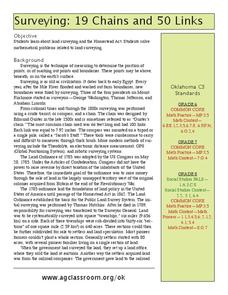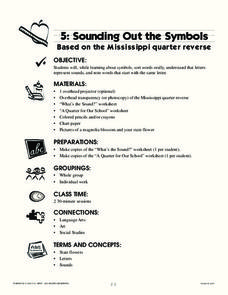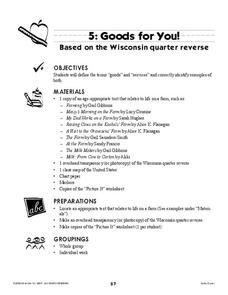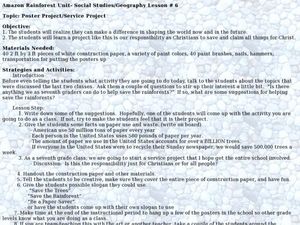NOAA
Climate, Weather…What’s the Difference?: Make an Electronic Temperature Sensor
What's the best way to record temperature over a long period of time? Scholars learn about collection of weather and temperature data by building thermistors in the fourth installment of the 10-part Discover Your Changing World series....
Curated OER
Florida Friendly Coloring Page
In this literacy activity, students color in the page that is centered around the topic of promoting Florida commerce or tourism.
Curated OER
A "State of the Arts" Coin 4-6
Students study the historical figures depicted on the penny,
nickel, dime, and quarter and explore how symbols of U.S. patriotism were used in their design. They research symbols of Texas and choose one to draw in a design for a Texas...
Curated OER
Learning About A Graphing Calculator
Students investigate the use of a graphing calculator in solving problems. In this algebra lesson, students solve polynomials problems using a calculator.
Curated OER
19 Chains and 50 Links
Students investigate surveys as it relates to chains and links. In this math lesson, students relate math to history and surveys done above, below and on the earths' surface. They review vocabulary pertaining to this lesson before moving...
Curated OER
Discovering Descriptions
Delve into the journey of Lewis and Clark using this lesson on Missouri. After sharing books on Lewis and Clark's journey across the United States, pupils discuss the descriptive language used in their writing, and come up with their own...
Curated OER
Sounding Out the Symbols
Using the states as a hook, kindergartners identify beginning sounds. They identify the initial sound in words like Mississippi and Indiana and complete a set of worksheets related to this skill.
Curated OER
Goods for You!
Have your class learn about Wisconsin and farming. Learners begin by listening to stories that describe farming and engage in a discussion of goods and services. They could also compare the goods and services provided in different states.
Curated OER
Children in the United States and Japan
Students locate Japan on a map or globe and describe the relative location of Japan. They use the Internet to investigate cultural characteristics of children in the United States and in Japan. They use a Venn Diagram as an...
Curated OER
Gettysburg: The Civil War's Costliest Battle
Learners research the Civil War and the Battle of Gettysburg. In this Gettysburg lesson, students analyze journals and letters written by the Gettysburg soldiers. Learners define Civil War soldier vocabulary words. Students compare and...
Curated OER
The U.S. White House
In this White House worksheet, students learn a few facts about the President's house in Washington D.C. by reading a one paragraph text. Students answer 6 multiple choice questions. This is an online interactive worksheet.
Curated OER
In Perfect Harmony: Teaching the World to Sing
First graders listen to music as the impetus to learn about the concept of Japanese harmony as it is understood in Japanese culture. They use the New Seeker's song, "I'd Like to Teach the World to Sing," to compare America and Japan...
Curated OER
Blocking Trade, or Blocking Aid?
Students examine various foreign conflicts in which the United States intervened, focusing on the causes of the conflicts, the United States' justification for entering the conflicts, and the outcomes of these interventions.
Curated OER
I Am Not a Crook
Students use video, Internet research and discussion to consider the presidency of Richard Nixon. They obtain information from multiple perspectives and form an opinion of how Richard Nixon should be remembered.
Curated OER
A New Phase In Town
Middle schoolers explore heat energy and how it is used to change the phase of matter, and discover that temperature does not increase or decrease until the phase change is complete. This extremely well-written plan is packed with great...
Curated OER
British Imperialism in India
Tenth graders learn how the differences between Indian and British cultural perspectives, as seen in works of art. Students participate in discussion of the differences in how individuals are viewes by others.
Curated OER
Hire the Best Unit
Students complete a activities to improve their career awareness. In this career awareness activity, students complete a 41 page packet of activities to learn how education can increase earning power, learn about employer attitudes and...
Curated OER
Just Like the Old Days
Students examine customs of rural Mongolia. They read and discuss a letter, discuss families, locate Mongolia on a map, reenact scenes from the letter, and write a prediction of how life change in rural Mongolia during the next 50 years.
Curated OER
Developing the Concept: Proportions
Learners solve problems with proportions. In this proportions lesson, students solve word problems as they learn about how to set up formulas for solving proportions. Learners then solve problems using proportions.
Curated OER
Amazon Rainforest Poster Project/Service Project
Students make efforts to save the rainforests. In this environmental stewardship lesson, students discuss facts about the resources of the rainforests. Students then create posters that encourage other to reduce their use of paper.
Curated OER
Hundred Chart
In this learning tool worksheet, students recognize the numbers from 1-100. This chart has multiply uses with various math activities.
Curated OER
Watch Out for Landslides
Students conduct an experiment. In this landslides lesson, students learn about landslides and discuss how they could minimize the risk of landslides. Students complete an experiment to see if changing the slope of the land...
Curated OER
Sounding Out the Symbols
Students examine the Mississippi state quarter and the Magnolia blossom. They discuss the "m" sound and other words that begin with "m". They discuss symbols that could represent their school and design a school quarter.
Curated OER
Learning to Use a Scale
In this scale activity, students measure items on a scale, and read examples. Students complete 4 questions on their own about scale measurement.























